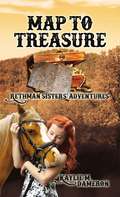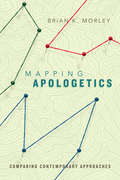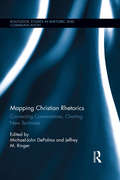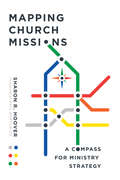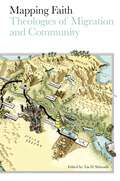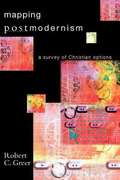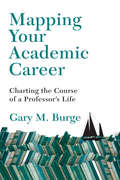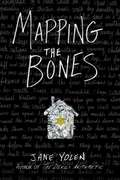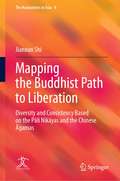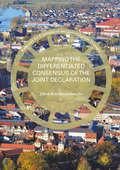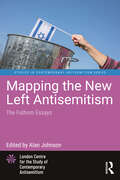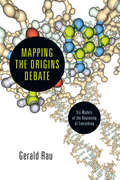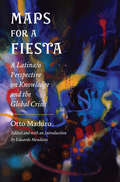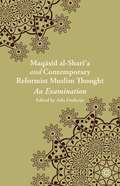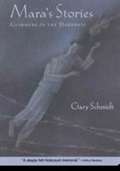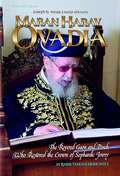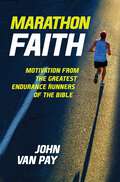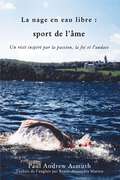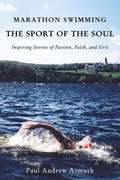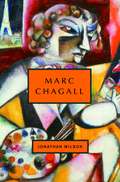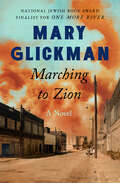- Table View
- List View
Map to Treasure: Rethman Sisters' Adventures
by Kaylie M. DameronMap to Treasure is a middle-grade novel about hidden pasts and the adventures of five sisters in a Christian family. Taking place in 2001, it is in Clyde, North Carolina where the girls are growing up. Elise Rethman is the youngest sister and also the main character, whose main problem is avoiding Diana, an annoying girl at Church who seems to want to &“steal&” Elise&’s best friend from her. At the beginning of the book, Elise is chased by a wild bear while she is out on the trails in her woods, riding her beloved horse, Blossom. After this event, her and her sisters are plunged into curiosity as their Dad seems to be hiding an important secret from them. When Diana comes to stay at the Rethman home while her parents are away, her and Elise are kidnapped while trail riding. Their captors threaten the girls to give them a box that conceals a map that leads to treasure, which Elise&’s father supposedly has. Her and Diana find themselves in a mess with their captors and each other. Together they have to figure out how to escape and push aside their pride to work together. After many happenings, Elise and Diana arrive safely home, Elise and her sisters are let in on the secrets their dad seemed to have been keeping from them and they are sent to New York to stay with their cousins and be out of harm&’s way. It is there that Elise discovers the key that would go along with the map to lead them where the treasure is and unlock the secret.
Mapping Apologetics: Comparing Contemporary Approaches
by Brian K. MorleyEveryone believes something. But how and why do people believe? What counts as evidence? How much can be assumed or believed by faith alone? When it comes to religious faith, the questions become at once more difficult and more important. Over the centuries, Christians have offered different approaches to explaining or defending the Christian faith, a discipline known as apologetics. But it has not always been clear how different apologetic methods work, or what each approach has to offer. In this comprehensive survey, Brian Morley provides an overview of Christian apologetic approaches and how they differ. He explores the historical and philosophical underpinnings of key figures and major schools of thought, from the presuppositionalism of Cornelius Van Til to the evidentialism of Gary Habermas. Moving beyond theory, Morley also covers apologetic application, demonstrating how each view works out in practical terms. This guide covers the complexities of apologetics in a way that is accessible to the nonspecialist. Even-handed and respectful of each apologist and their contribution, this book provides the reader with a formidable array of defenses for the faith.
Mapping Christian Rhetorics: Connecting Conversations, Charting New Territories (Routledge Studies in Rhetoric and Communication)
by Jeffrey M. Ringer Michael-John DePalmaThe continued importance of Christian rhetorics in political, social, pedagogical, and civic affairs suggests that such rhetorics not only belong on the map of rhetorical studies, but are indeed essential to the geography of rhetorical studies in the twenty-first century. This collection argues that concerning ourselves with religious rhetorics in general and Christian rhetorics in particular tells us something about rhetoric itself—its boundaries, its characteristics, its functionings. In assembling original research on the intersections of rhetoric and Christianity from prominent and emerging scholars, Mapping Christian Rhetorics seeks to locate religion more centrally within the geography of rhetorical studies in the twenty-first century. It does so by acknowledging work on Christian rhetorics that has been overlooked or ignored; connecting domains of knowledge and research areas pertaining to Christian rhetorics that may remain disconnected or under connected; and charting new avenues of inquiry about Christian rhetorics that might invigorate theory-building, teaching, research, and civic engagement. In dividing the terrain of Christian rhetorics into four categories—theory, education, methodology, and civic engagement—Mapping Christian Rhetorics aims to foster connections among these areas of inquiry and spur future future collaboration between scholars of religious rhetoric in a range of research areas.
Mapping Church Missions: A Compass for Ministry Strategy
by Paul Borthwick Sharon R. HooverThe terrain of church missions is often bewildering Should we prioritize evangelism or works of service? Local ministries or overseas missions? What's more important: giving our money or giving our time? Crisis relief or building sustainable, long-term ministries? And what about the often debated pros and cons of short-term missions trips? In Mapping Church Missions, Sharon Hoover brings her years of experience in local church missions to bear on these and other thorny questions. Instead of taking a hardline stance on one end of the spectrum or the other, she approaches each question with nuance, adding helpful data, presenting new perspectives, and always pressing gently past surface questions to the heart of the matter. Whether we're fully aware of it or not, our churches come up against these questions whenever we consider how best to use our resources for the mission of God. Written by an experienced guide, this book maps the terrain of church missions in careful detail, helping us plot our church's unique course as we seek to serve Christ's kingdom.
Mapping Faith: Theologies of Migration and Community
by David Mason Sheila Curran Ruth Padel Alison Phipps Ibrahim Mogra Faiza Omar Ric Stott Oliver Joseph Katy Radford Julie Khovacs Ivan Khovacs Hassan Rabbani Katherine Baxter Yvonne Green Tawona Sithole Rachel Godfrey Sofia Rehman Michael Nausner Robyn Ashworth-Steen Sayed Razawi Jacqueline Nicholls Aviva Dautch Pádraig Ó Tuama Harvey Kwiyani Hajra Williams Sally Style Mohamed Omar Jennifer Langer Issam Kourbaj Nazneen Ahmed Amir DarwishThis enlightening edited collection shows how migration shapes the lives of faith communities - and vice versa - through diverse prisms including diaspora, generational change, cultural conflict, conceptions of 'ministry' and artistic response. The contributors comprise writers, poets and artists from the three largest Abrahamic faiths (Judaism, Christianity, Islam) and beyond. They show how issues of migration are addressed through a variety of different media such as theological debate and shared community action, poetry and art.As issues of migration are an important factor in so many political and social debates, faith communities are looking for guidance on how to deepen their theological understanding of migration. This book helps them to reflect on their own practices and experiences, learn from their own traditions and engage in dialogue with diverse communities.
Mapping New Terrain in Queer Religious Scholarship: Essays in Honor of John Eastburn Boswell (Gender, Theology and Spirituality)
by Bernard S. SchlagerMapping New Terrain in Queer Religious Scholarship builds upon the work and legacy of Professor John Boswell, bringing together contributions that were delivered at the annual CLGS Boswell Lecture Series at Pacific School of Religion, USA. Boswell is lauded as a major scholar in gender and sexuality studies and is recognized as an early advocate for the full inclusion of LGBTQ people in faith communities. Drawing inspiration from Boswell’s ground-breaking book Christianity, Social Tolerance, and Homosexuality (1980), the chapters address a variety of relevant topics in theology, scripture, queer studies, ethics, and social justice. Boswell’s legacy of scholarly excellence and his prophetic activism continue to live on in the writings of these noted academics, religious leaders, and activists. The book will be of particular interest to scholars working in the fields of gender and sexuality studies, religious studies, and the history of Christianity.
Mapping Postmodernism: A Survey of Christian Options
by Robert GreerBy now we've all heard the word postmodernism. But what is it? Can it be defined? Does it really represent a monumental shift away from how we use to think about right and wrong, truth, the world, and even the whole cosmos? Most important, how should Christians respond? Robert C. Greer helps us grasp the nature of the shifts in thinking and believing that are taking place in our world. More important, he helps us navigate the complex debate among Christians as to how best to respond to these new challenges. Astutely he maps four different ways Christian thinkers have recommended we respond. These alternatives are represented by four theologians: Francis Schaeffer, Karl Barth, John Hick and George Lindbeck. Greer warns that being merely for or against postmodernism is inadequate. He guides us across the terrain of alternatives along a path that leads neither back to the land of modernism nor to the wild frontiers of postmodernist relativism. Acknowledging the relative strengths and weaknesses of these options, Greer turns us to a thoroughly Christian theology that points beyond them to the true Subject who makes knowledge possible through the language of revelation and relationship with God. This book is an illuminating map for all those who feel lost in the maze of conflicting analyses of postmodernism and are looking for a faithful way forward .
Mapping Your Academic Career: Charting the Course of a Professor's Life
by Gary M. BurgeNijay Gupta's Best Academic NT Books of 2015, Honorable Mention, AcademiaMapping Your Academic Career
Mapping the Bones
by Jane YolenFrom the best-selling and award-winning author of The Devil's Arithmetic, Jane Yolen, comes her first Holocaust novel in nearly thirty years. Influenced by Dr. Mengele's sadistic experimentations, this story follows twins as they travel from the Lodz ghetto, to the partisans in the forest, to a horrific concentration camp where they lose everything but each other. It's 1942 in Poland, and the world is coming to pieces. At least that's how it seems to Chaim and Gittel, twins whose lives feel like a fairy tale torn apart, with evil witches, forbidden forests, and dangerous ovens looming on the horizon. But in all darkness there is light, and the twins find it through Chaim's poetry and the love they have for each other. Like the bright flame of a Yahrzeit candle, his words become a beacon of memory so that the children and grandchildren of survivors will never forget the atrocities that happened during the Holocaust.Filled with brutality and despair, this is also a story of poetry and strength, in which a brother and sister lose everything but each other. Nearly thirty years after the publication of her award-winning and bestselling The Devil's Arithmetic and Briar Rose, Yolen once again returns to World War II and captivates her readers with the authenticity and power of her words.
Mapping the Buddhist Path to Liberation: Diversity and Consistency Based on the Pāli Nikāyas and the Chinese Āgamas (The Humanities in Asia #9)
by Jianxun ShiDue to the diversity in Buddhism, its essence remains a puzzle. This book investigates the Buddhist path to liberation from a practical and critical perspective by searching for patterns found in the Pāli Nikāyas and the Chinese Āgamas. The early discourses depict the Buddhist path as a network of routes leading to the same goal: liberation from suffering. This book summarizes various teachings in three aspects, provides a template theory for systematically presenting the formulas of the sequential training of the path, and analyses the differences and similarities among diverse descriptions of the path in the early Buddhist texts. By offering a comprehensive map of the Buddhist path, this book will appeal to scholars and students of Buddhist studies as well as those practitioners with a serious interest in the Buddhist path.
Mapping the Differentiated Consensus of the Joint Declaration
by Jakob Karl RinderknechtThis book uses the insights of cognitive linguistics to argue for the possibility of differentiated consensus between separated churches. The Joint Declaration on the Doctrine of Justification, signed by the Lutheran World Federation and the Roman Catholic Church in 1999, represents the high water mark of the twentieth-century ecumenical movement. It declares that the sixteenth-century condemnations related to justification do not condemn the teachings of the partner church. Some critics reject the agreement, arguing that a consensus that is differentiated is not actually a consensus. In this book, Jakob Karl Rinderknecht shows that mapping the "cognitive blends" that structure meaning can reveal underlying agreement within apparent theological contradictions. He traces Lutheran and Catholic positions on sin in the baptized, especially the Lutheran simul iustus et peccator and the Catholic insistence that concupiscence in the baptized is not sin. He demonstrates that the JDDJ reconciles these positions, and therefore that a truly differentiated consensus is possible.
Mapping the New Left Antisemitism: The Fathom Essays (Studies in Contemporary Antisemitism)
by Alan JohnsonMapping the New Left Antisemitism: The Fathom Essays provides a comprehensive guide to contemporary Left antisemitism. The rise of a new and largely left-wing form of antisemitism in the era of the Jewish state and the distinction between it and legitimate criticism of Israel are now roiling progressive politics in the West and causing alarming spikes in antisemitic incitement and incidents. Fathom journal has examined these questions relentlessly in the first decade of its existence, earning a reputation for careful textual analysis and cogent advocacy. In this book, the Fathom essays are contextualised by three new contributions: Lesley Klaff provides a map of contemporary antisemitic forms of antizionism, Dave Rich writes on the oft-neglected lived experience of the Jewish victims of contemporary antisemitism and David Hirsh assesses the intellectual history of the left from which both Fathom and his own London Centre for the Study of Contemporary Antisemitism, as well as this book series, have emerged. Topics covered by the contributors include antisemitic antizionism and its underappreciated Soviet roots; the impact of analogies with the Nazis; the rise of antisemitism on the European continent, exploring the hybrid forms emerging from a cross-fertilisation between new left, Christian and Islamist antisemitism; the impact of antizionist activism on higher education; and the bitter debates over the adoption of the oft-misrepresented International Holocaust Remembrance Alliance (IHRA) definition of antisemitism. This work will be of considerable appeal to scholars and activists with an interest in antisemitism, Jewish studies and the politics of Israel.
Mapping the Origins Debate: Six Models of the Beginning of Everything
by Gerald RauMidwest Publishing Awards ShowMapping the Origins Debate
Mapping the Ottomans
by Palmira Brummett"Simple paradigms of Muslim-Christian confrontation and the rise of Europe in the seventeenth century do not suffice to explain the ways in which European mapping envisioned the "Turks" in image and narrative. Rather, maps, travel accounts, compendia of knowledge, and other texts created a picture of the Ottoman Empire through a complex layering of history, ethnography, and eyewitness testimony, which juxtaposed current events to classical and biblical history; counted space in terms of peoples, routes, and fortresses; and used the land and seascapes of the map to assert ownership, declare victory, and embody imperial power's reach. Enriched throughout by examples of Ottoman self-mapping, this book examines how Ottomans and their empire were mapped in the narrative and visual imagination of early modern Europe's Christian kingdoms. The maps serve as centerpieces for discussions of early modern space, time, borders, stages of travel, information flows, invocations of authority, and cross-cultural relations"--"This book examines how the Ottomans and their empire were mapped in the narrative and visual imagination of the Christian kingdoms of early modern Europe. Simple paradigms of Muslim-Christian confrontation and the 'rise' of Europe in the seventeenth century do not suffice to explain the ways in which European mapping envisioned the "Turks" in image and narrative. Rather, maps, travel accounts, compendia of knowledge, and other texts created a picture of the Ottoman empire through a complex layering of history, ethnography, and eyewitness testimony which juxtaposed current events to classical and Biblical history; counted space in terms of peoples, routes, and fortresses; and used the land and seascapes of the map to assert ownership, declare victory, and embody the reach of imperial power. Maps here serve as centerpieces for a discussion of early modern space, time, borders, stages of travel, information flows, invocations of authority, and cross-cultural relations. The book is enriched throughout by examples of Ottoman self-mapping"--
Maps for a Fiesta: A Latina/o Perspective on Knowledge and the Global Crisis
by Otto MaduroWhat can theology offer in the context of neoliberalism, globalization, growing inequality, and an ever more ecologically precarious planet that disproportionately affects the poor? This book, by one of the country’s best-known Latino theologians, explores possibilities for liberation from the forces that would impose certain forms of knowledge on our social world to manipulate our experience of identity, power, and justice.Beautifully written in a refreshingly direct and accessible prose, Maduro’s book is nevertheless built upon subtly articulated critiques and insights. But to write a conventional academic tractatus would have run counter to Maduro’s project, which is built on his argument that ignorance is masked in the language of expertise, while true knowledge is dismissed because it is sometimes articulated in pedestrian language by those who produce it through the praxis of solidarity and struggle for social justice.With a generosity and receptivity to his readers reminiscent of letters between old friends, and with the pointed but questioning wisdom of a teller of parables, Maduro has woven together a twenty-first-century reply to Marx’s “Theses on Feuerbach.” Neither conventional monograph nor memoir, neither a theological nor a political tract, but with elements of all of these, Maps for a Fiesta arrives as Maduro’s philosophical and theological testament—one that celebrates the knowledge-work and justice-making of the poor.What Maduro offers here is a profound meditation on the relationship between knowledge and justice that could be read as a manifesto against the putatively unknowable world that capitalist chaos has made, in favor of a world that is known by the measure of its collective justice. His fiesta grants us the joy that nourishes us in our struggles, just as knowledge gives us the tools to build a more just society. What Maduro offers is nothing less than an epistemology of liberation.
Maps of Consciousness: The Classic Text on Exploring the Mind and Expanding Awareness
by Ralph MetznerA classic guide to expanding perception and consciousness development• Explores six ancient yet timeless systems for exploring the mind: the I Ching, Tantra, Tarot, astrology, alchemy, and the yoga philosophy of Actualism • Shares exercises from each system and illuminates the key stages in the journey of consciousness development • Shows how each of these disciplines can help you become a fully aware and conscious participant in your own spiritual evolution In this highly acclaimed classic, psychedelic elder Ralph Metzner presents a guide to six ancient systems, once known only to the initiated few, to expand awareness and free your consciousness from exterior limitations and cultural conditioning. Metzner begins with the I Ching, revered by the Chinese as the oldest and wisest book in the world. He explains how it reveals change as the evolutionary constant and offers a hands-on method of divination and guidance. He explores the Hindu and Buddhist Tantras of medieval India, ancient practices celebrating the union of male and female energies that transmute ordinary sense experience into ecstatic ritual worship. He examines the Tarot, revealing how the cards act as culture-transcending mirrors, bringing us through worlds of darkness and light in a complex journey. He looks at the practice of alchemy, explaining how it is a &“psychic chemistry&” of inner union through which we can transform planetary and cosmic energies. He explores the esoteric aspects of astrology, revealing the rhythmic cycles of the planets and how their phases may be experienced in terms of motion and emotion. He then examines in depth the yoga philosophy of Actualism, centered on the techniques of Agni Yoga, which allow you to use your living &“inner fire&” to illuminate the shadow parts of consciousness and burn out that which obstructs the free flow of energy. With a new foreword by UC Berkeley professor of neurobiology David E. Presti and featuring all of the original diagrams, this edition of Metzner&’s classic text shows how each of these disciplines can help the modern individual become a fully aware and conscious participant in their own spiritual evolution.
Maqāṣid al-Sharī‘a and Contemporary Reformist Muslim Thought: An Examination
by Adis DuderijaIt is the first study which comprehensively, systematically and critically examines the role and usefulness of the concept of Maqasid al-Shari'a (higher Objectives of Islamic Law) in contemporary Muslim reformist thought in relation to number of specific issues pertaining to Islamic legal philosophy, law, ethics and the socio-political sphere.
Mara's Stories: Glimmers in the Darkness
by Gary SchmidtA testament to the power of stories, and how they may bring hope even in times of darkness. As night falls, the women gather their children to listen to Mara tell her stories. They are stories of light and hope and freedom, stories of despair and stories of miracles, stories of expected pain and stories of unexpected joy--all told in the darkness of the concentration camp barracks. Through extensive research noted in the back of the book, Gary Schmidt has skillfully woven together stories from such sources as the Jewish religious scholar, Martin Buber; Holocaust survivor, Elie Wiesel; and folklorists, Steve Zeitlin and Yaffa Eliach. Combining lore of the past with tales born in the concentration camps, Mara's stories speak to us from a time that must never be forgotten.
Maran Harav Ovadia: The Revered Gaon And Posek Who Restored The Crown Of Sephardic Jewry
by Yehuda HeimowitzHe had a mind big enough to master all of Torah. A spirit big enough to lead his people. And a heart big enough to contain all of Klal Yisrael. Maran Harav Ovadia Yosef met with Prime Ministers, Presidents, great rabbis - and the humblest Jew seeking advice or a berachah. He inspired and led a revolution in Sephardic society. But whether he was the ten-year old son of a poor grocer pleading to study Torah constantly, or an ailing man in his '90s keeping a schedule that would have tired someone half his age, Harav Ovadia Yosef had only one agenda: Torah. Always Torah. And everyday life according to the Torah. The brilliant gaon was an unyielding warrior for Torah. As a young rabbi in Cairo, he courageously stood firm for halachah even as a gun was pointed at his head. In the early days of the State of Israel, he struggled to bring his Sephardic brethren back to the magnificent Torah traditions that many were abandoning with terrifying haste. His encyclopedic knowledge was breathtaking and unparalleled. In his scores of brilliant sefarim he "restored the crown to its glory," fighting the battles of Torah and maintaining the preeminence of Maran Beit Yosef. As unyielding as he was in defense of Torah, so was he compassionate in personal encounters. He loved all Jews, and they loved him. When there were hundreds of agunot after Israel's wars, it was to him that all turned to find the keys to their chains. So multifaceted a leader needs a multifaceted biography. In Maran Harav Ovadia we meet the sage, the leader, the visionary, the loving father of all in distress. Rabbi Yehudah Heimowitz, author of the bestselling biographies Rav Elyashiv and Rav Nosson Tzvi, brings us Maran Harav Ovadia Yosef's rich and historic life and includes hundreds of stories and vignettes based on recollections of his family, friends, and colleagues. Generous excerpts from Harav Ovadia's personal writings give us a first-hand glimpse of his encounters and achievements, while hundreds of photos and historical documents offer a visual history of his extraordinary life. This book is the story of a great shaper of our era, a man who brought the Torah to hundreds of thousands.
Marathon Faith: Motivation from the Greatest Endurance Runners of the Bible
by John Van PayGOD WANTS TO FINISH WHAT HE STARTED IN YOU Surrendering your life to Jesus is the greatest decision you will ever make, but that's just the starting line. Many of us begin a journey of following Jesus without a realistic expectation of the price required to finish our spiritual race. As a result, we lose heart when the road becomes difficult. In Marathon Faith: Motivation from the Greatest Endurance Runners of the Bible, pastor and marathon runner John Van Pay offers help. Van Pay shows how the "endurance runners of the Bible" overcame obstacles on their faith journeys and how you too can finish your spiritual race through their example. By adding personal adventures, humorous mishaps, and grueling struggles from his own endurance races and life experiences, Van Pay shares in vulnerable ways how God helps when things get tough. You too can finish strong.
Marathon Swimming The Sport of the Soul (French Language Edition): Inspiring Stories of Passion, Faith, and Grit
by Paul AsmuthFRENCH EDITION.When the plans and dreams of a young swimmer are shattered by the United States’ boycott of the 1980 Olympic Games in Moscow, God opens the door of new opportunities. For Paul Asmuth, then 22, it is the end of an unfulfilled dream, and the beginning of another journey, this one remarkable and life-changing. Plunging into the astounding, grueling, hypnotic, and often oddly beautiful world of international marathon swimming competitions, Asmuth experiences both triumph and tragedy, and, in a process as long and punishing as the marathon swims themselves, slowly discovers the best of himself. If you care for resumes, Asmuth is one of the most successful marathon swimmers in history. In the sapphire seas off Italy, in the frigid lakes of Quebec, Canada, in the marshy back bays of New Jersey, in the questionable waters ringing Manhattan, swimming distances from twenty to forty miles, Asmuth emerged victorious, often to thunderous acclaim. After multiple victories at the twenty-six-mile swim across Quebec’s Lac Memphremagog, up to 20,000 spectators would cheer and call him “le roi” (the king) of their lake. But true victory is not a matter of accolades or medals, and the stories that make a real difference unfold behind the headlines. Overcoming self-doubt, nausea, hypothermia, cruel tides and dark, watery shadows both real and imagined, Asmuth calls upon passion, iron-clad resolve, and steadfast faith to emerge a changed man, attaining success in its truest and most honest form. This success does not end when Asmuth retires from competing. Coming full circle, when he hangs up his swim suit, Paul takes the knowledge, lessons and examples he learned from his own experiences and some of the world’s greatest coaches, and turns to helping others with their swimming dreams. His prayers to give back are answered by coaching opportunities at multiple World Championships and two Olympic Games, where marathon swimming is now a contested event. But this is not just the tale of a swimmer. Like any great story, Paul’s transcends sport. By listening to the voice of faith and not of fear, new dreams are born, and God’s plans are revealed.
Marathon Swimming The Sport of the Soul: Inspiring Stories of Passion, Faith, and Grit
by Paul Andrew AsmuthWhen the plans and dreams of a young swimmer are shattered by the United States’ boycott of the 1980 Olympic Games in Moscow, God opens the door of new opportunities. For Paul Asmuth, then 22, it is the end of an unfulfilled dream, and the beginning of another journey, this one remarkable and life-changing. Plunging into the astounding, grueling, hypnotic, and often oddly beautiful world of international marathon swimming competitions, Asmuth experiences both triumph and tragedy, and, in a process as long and punishing as the marathon swims themselves, slowly discovers the best of himself. If you care for resumes, Asmuth is one of the most successful marathon swimmers in history. In the sapphire seas off Italy, in the frigid lakes of Quebec, Canada, in the marshy back bays of New Jersey, in the questionable waters ringing Manhattan, swimming distances from twenty to forty miles, Asmuth emerged victorious, often to thunderous acclaim. After multiple victories at the twenty-six-mile swim across Quebec’s Lac Memphremagog, up to 20,000 spectators would cheer and call him “le roi” (the king) of their lake. But true victory is not a matter of accolades or medals, and the stories that make a real difference unfold behind the headlines. Overcoming self-doubt, nausea, hypothermia, cruel tides and dark, watery shadows both real and imagined, Asmuth calls upon passion, iron-clad resolve, and steadfast faith to emerge a changed man, attaining success in its truest and most honest form. This success does not end when Asmuth retires from competing. Coming full circle, when he hangs up his swim suit, Paul takes the knowledge, lessons and examples he learned from his own experiences and some of the world’s greatest coaches, and turns to helping others with their swimming dreams. His prayers to give back are answered by coaching opportunities at multiple World Championships and two Olympic Games, where marathon swimming is now a contested event. But this is not just the tale of a swimmer. Like any great story, Paul’s transcends sport. By listening to the voice of faith and not of fear, new dreams are born, and God’s plans are revealed.
Marc Chagall (Jewish Encounters Series)
by Jonathan WilsonNovelist and critic Jonathan Wilson clears away the sentimental mists surrounding an artist whose career spanned two world wars, the Russian Revolution, the Holocaust, and the birth of the State of Israel. Marc Chagall's work addresses these transforming events, but his ambivalence about his role as a Jewish artist adds an intriguing wrinkle to common assumptions about his life. Drawn to sacred subject matter, Chagall remains defiantly secular in outlook; determined to "narrate" the miraculous and tragic events of the Jewish past, he frequently chooses Jesus as a symbol of martyrdom and sacrifice. Wilson brilliantly demonstrates how Marc Chagall's life constitutes a grand canvas on which much of twentieth-century Jewish history is vividly portrayed. Chagall left Belorussia for Paris in 1910, at the dawn of modernism, looking back dreamily on the world he abandoned. After his marriage to Bella Rosenfeld in 1915, he moved to Petrograd, but eventually returned to Paris after a stint as a Soviet commissar for art. Fleeing Paris steps ahead of the Nazis, Chagall arrived in New York in 1941. Drawn to Israel, but not enough to live there, Chagall grappled endlessly with both a nostalgic attachment to a vanished past and the magnetic pull of an uninhibited secular present. Wilson's portrait of Chagall is altogether more historical, more political, and edgier than conventional wisdom would have us believe-showing us how Chagall is the emblematic Jewish artist of the twentieth century. Visit nextbook. org/chagall for a virtual museum of Chagall images. From the Hardcover edition.
Marching to Zion: A Novel
by Mary GlickmanA family of Eastern European refugees finds a home in racially charged St. Louis in this sweeping historical novel from a National Jewish Book Award finalist. In 1916, Mags Preacher arrives in the big city of St. Louis, fresh from the piney woods, hoping to learn the beauty trade. Instead, she winds up with a job at Fishbein&’s Funeral Home, run by an émigré who came to America to flee the pogroms of Russia. Mags knows nothing about Jews except that they killed the Lord Jesus Christ, but by the time her boss saves her life during the race riots in East St. Louis, all her perceptions have changed.Marching to Zion is the story of Mags and of Mr. Fishbein, but it&’s also the story of Fishbein&’s daughter, Minerva, a beautiful redhead with an air of danger about her, and Magnus Bailey, Fishbein&’s charismatic business partner and Mags&’s first friend in town. When Magnus falls for Minerva&’s willful spirit, he&’ll learn just how dangerous she can be for a black man in America. Readers of Mary Glickman&’s One More River will celebrate the return of Aurora Mae Stanton, who joins a cast of vibrant new characters in a tale that stretches from East St. Louis, Missouri, to Memphis, Tennessee, from World War I to the Great Depression. Hailed as &“a powerful reminder of the discrimination and unspeakable hardships African Americans suffered,&” Marching to Zion is a gripping love story, a fascinating angle on history, and a compelling meditation on justice and fate (Jewish Book Council).
